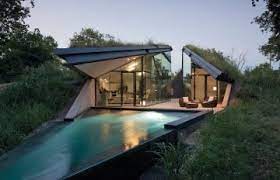The Future of Sustainable Housing
In recent years, the concept of sustainable housing has gained significant traction as individuals and governments alike recognise the importance of reducing our environmental impact and creating more eco-friendly living spaces. Sustainable housing refers to the design, construction, and operation of homes that are energy-efficient, environmentally responsible, and economically viable.
Key Features of Sustainable Housing
Sustainable housing incorporates a variety of features that set it apart from traditional homes. These features include:
- Energy Efficiency: Sustainable homes are designed to minimise energy consumption through the use of insulation, energy-efficient appliances, and renewable energy sources such as solar panels.
- Water Conservation: Water-saving fixtures, rainwater harvesting systems, and greywater recycling help reduce water wastage in sustainable homes.
- Material Selection: Sustainable housing uses environmentally friendly materials that are sourced responsibly and have minimal impact on the environment.
- Passive Design: Passive heating and cooling strategies maximise natural light and ventilation to reduce the need for artificial heating and cooling systems.
- Green Spaces: Incorporating green spaces within or around sustainable homes helps improve air quality, provide habitat for wildlife, and create a more pleasant living environment.
The Benefits of Sustainable Housing
The shift towards sustainable housing offers a wide range of benefits for both individuals and society as a whole. Some key benefits include:
- Lower Utility Bills: Energy-efficient design elements can lead to significant savings on electricity and water bills over time.
- Reduced Environmental Impact: By using renewable energy sources and minimising resource consumption, sustainable homes help lower carbon emissions and protect natural habitats.
- Improved Indoor Air Quality: Green building materials and proper ventilation contribute to healthier indoor air quality for residents.
- Increased Property Value: Sustainable features can enhance the market value of a home due to growing demand for eco-friendly properties.
- Social Responsibility: Choosing sustainable housing options demonstrates a commitment to environmental stewardship and sustainability practices.
In conclusion, sustainable housing represents a promising solution to address environmental challenges while creating comfortable, efficient living spaces for current and future generations. As technology advances and awareness grows, we can expect to see an increasing number of sustainable homes shaping the future of residential architecture around the world.
Understanding Sustainable Housing: Key Concepts, Features, and Benefits
- What is sustainable housing and why is it important?
- What are the key features of a sustainable home?
- How can I make my existing home more sustainable?
- Are there financial incentives available for building or retrofitting sustainable homes?
- What are the environmental benefits of living in a sustainable house?
What is sustainable housing and why is it important?
Sustainable housing encompasses the design, construction, and operation of homes that prioritise energy efficiency, environmental responsibility, and economic viability. It is essential due to its significant impact on reducing carbon emissions, conserving natural resources, and promoting healthier living environments. By incorporating features such as energy-efficient appliances, renewable energy sources, water conservation systems, and eco-friendly materials, sustainable housing not only lowers utility bills for residents but also contributes to mitigating climate change and fostering sustainable development. Embracing sustainable housing practices is crucial in addressing environmental challenges and creating a more resilient and environmentally conscious society for future generations.
What are the key features of a sustainable home?
When considering the key features of a sustainable home, several crucial elements come to light. Energy efficiency stands out as a cornerstone, achieved through strategies like proper insulation, energy-saving appliances, and renewable energy sources such as solar panels. Water conservation plays a vital role, with features like water-saving fixtures and rainwater harvesting systems helping to reduce water wastage. Thoughtful material selection prioritises environmentally friendly options that have minimal impact on the planet. Passive design principles enhance comfort and reduce energy consumption by maximising natural light and ventilation. Additionally, incorporating green spaces within or around the home contributes to a healthier environment and enhances overall sustainability.
How can I make my existing home more sustainable?
To make your existing home more sustainable, there are several steps you can take to reduce its environmental impact and increase energy efficiency. Start by conducting an energy audit to identify areas where improvements can be made, such as upgrading insulation, sealing air leaks, and replacing inefficient appliances with energy-efficient models. Consider installing solar panels to generate renewable energy and reduce reliance on traditional power sources. Implement water-saving fixtures, such as low-flow taps and showerheads, and explore options for rainwater harvesting to minimise water wastage. Additionally, incorporating passive design strategies like maximising natural light and ventilation can help lower energy consumption and enhance overall sustainability in your home. By taking these measures, you can transform your existing home into a more eco-friendly and sustainable living space.
Are there financial incentives available for building or retrofitting sustainable homes?
Many countries and regions offer a range of financial incentives to encourage the construction or retrofitting of sustainable homes. These incentives aim to support homeowners, builders, and developers in implementing eco-friendly practices and technologies by offsetting the initial costs involved. Examples of financial incentives include grants, tax credits, rebates, low-interest loans, and subsidies for energy-efficient upgrades or renewable energy installations. By taking advantage of these financial incentives, individuals and businesses can not only reduce their environmental footprint but also benefit from cost savings in the long run while contributing to a more sustainable future for all.
What are the environmental benefits of living in a sustainable house?
Living in a sustainable house offers a multitude of environmental benefits. By incorporating energy-efficient design elements, such as insulation and renewable energy sources like solar panels, sustainable homes significantly reduce energy consumption and lower carbon emissions. Water-saving fixtures and rainwater harvesting systems help conserve water resources, while green building materials minimise environmental impact. Additionally, passive heating and cooling strategies enhance indoor comfort without relying heavily on artificial heating or cooling systems. Overall, choosing to live in a sustainable house not only reduces one’s ecological footprint but also contributes to a healthier planet for future generations.

